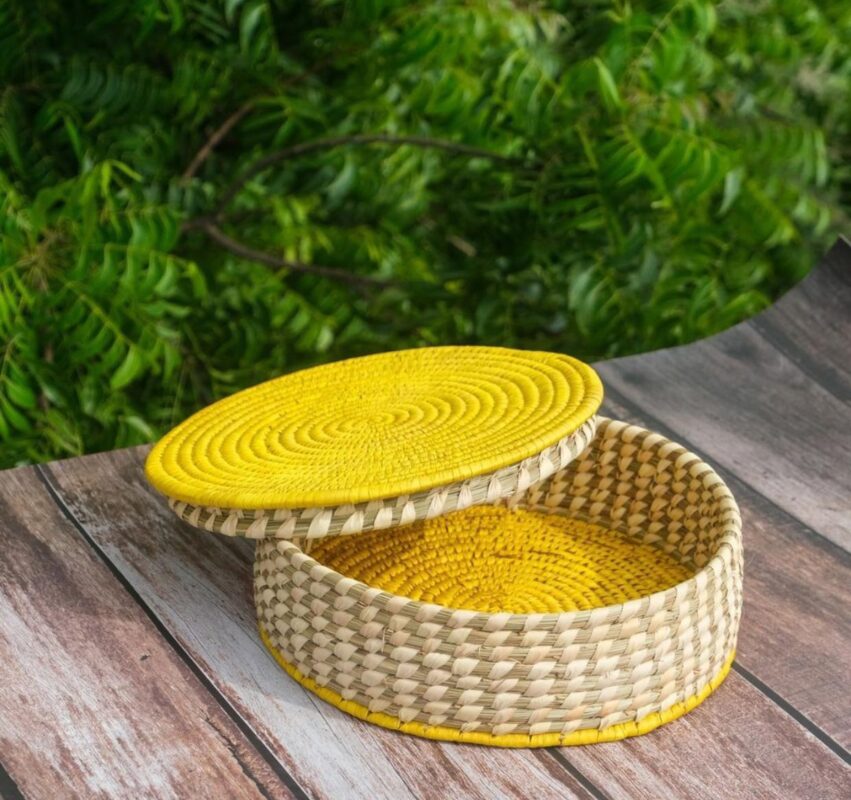
In the tribal heartlands of Mayurbhanj, Odisha, a humble grass is quietly revolutionizing both rural economies and the world of eco-friendly handicrafts. Sabai grass, a perennial plant (Eulaliopsis binata), has long been an integral part of life in this region, but it is only in recent years that its versatility and beauty have captured the global imagination.
The Origin of Sabai Grass in Mayurbhanj: A Tradition Passed Down Through Generations
Sabai grass has deep roots in Mayurbhanj, where it grows abundantly in the region’s dry, arid landscapes. For generations, this sturdy grass has been a source of livelihood for local communities. Its fibers are woven into a range of functional and decorative items, from baskets and mats to roti boxes and plant holders. The tradition of crafting with Sabai grass is an ancient one, passed down through families and communities. The folklore of the region often speaks of the grass as a gift from nature—providing shelter, sustenance, and a sense of connection to the earth. In local tales, the grass is often linked to the goddess of the land, symbolizing both protection and prosperity.
Why Sabai Grass is a Worthy Material for Handicrafts
What makes Sabai grass stand out in the world of handicrafts? It’s the unique combination of durability, flexibility, and aesthetic appeal. The natural golden-brown color of the grass, or its ability to take on vibrant hues with eco-friendly dyes, gives each product a distinctive charm. Sabai grass is lightweight yet strong, which makes it ideal for crafting a wide range of items that are both functional and beautiful.
The versatility of Sabai grass is unmatched—it’s used in everything from storage baskets to home décor accessories like table mats and coasters. One of the most notable products is the Sabai grass roti box, which helps keep bread fresh for hours. In every piece, artisans incorporate intricate patterns and motifs, adding an artistic touch that speaks to the cultural heritage of the region.
Changing Lives in Mayurbhanj: The Impact on Local Communities
For the people of Mayurbhanj, Sabai grass isn’t just a craft—it’s a lifeline. Historically, many in this rural district lived in poverty, relying on subsistence farming and limited access to resources. With the rise of Sabai grass handicrafts, however, women have found a new source of income, and local communities have experienced an economic uplift.
The process is entirely handwoven, and the creation of each product is a labor of love. It’s also a skill that has allowed artisans, particularly women, to assert themselves as key players in the local economy. By transforming a simple grass into a beautiful product, women are gaining financial independence, a stronger voice in their homes and communities, and a sense of pride in their craft.
How Shree Rang Bazaar Supports Rural Women and Empowerment
A significant part of this transformation has been driven by organizations like Shree Rang Bazaar, which works directly with self-help groups (SHGs) in Mayurbhanj. These SHGs consist mainly of women from rural areas, and by sourcing Sabai grass products directly from them, Shree Rang Bazaar helps bridge the gap between these artisans and the global market.
This has allowed rural women to earn a stable income, thus improving their quality of life and fostering social capital in the community.
Sabai Grass: From Rural India to Trendy Global Markets
The beauty and sustainability of Sabai grass products haven’t gone unnoticed. As global awareness of eco-friendly living grows, Sabai grass has found a new audience beyond India. International consumers and designers are increasingly drawn to these products not only for their environmental benefits but also for their craftsmanship and artistry.
Sabai grass is becoming a trendy material in home décor worldwide. From stylish baskets to chic table mats, Sabai grass items are seen as eco-conscious alternatives to plastic and synthetic products. As the world shifts toward more sustainable living, the global market for Sabai grass is expanding, with Shree Rang Bazaar playing a key role in connecting these rural artisans to a larger audience.
The Global Impact of Choosing Sabai Grass
Choosing Sabai grass products is more than just an aesthetic choice—it’s a decision to support sustainable practices and empower rural communities. When you buy a Sabai grass handicraft, you’re not just purchasing a product; you’re investing in the future of Mayurbhanj’s artisans, their families, and their communities.
From rural villages in Odisha to homes across the world, Sabai grass represents a powerful fusion of tradition, sustainability, and empowerment. As it continues to grow in popularity, it stands as a shining example of how a simple, natural resource can change lives and help protect the planet.
